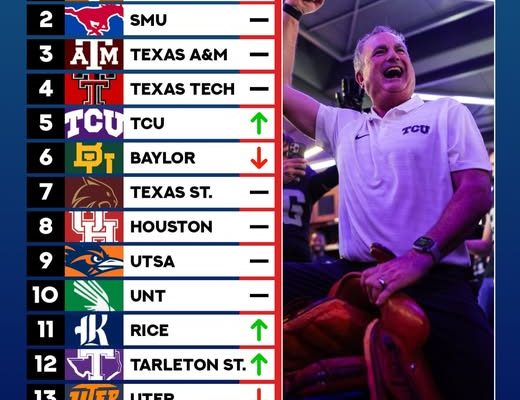The state of Texas has always carried a special weight in the landscape of high school and college athletics, and with each season the rankings that emerge from its deeply competitive programs become a pulse check on where the balance of power lies across the Lone Star State. On September 2, the release of the latest Top 15 rankings once again sparked debates, conversations, and spirited rivalries, as schools and their communities gauged how far they’ve come and how far they still have to go. Texas is not just another state when it comes to football and athletics—it is a proving ground, a place where rising contenders either solidify their reputations or collapse under the weight of immense competition. These rankings carry significance far beyond mere bragging rights; they are signals of cultural pride, indicators of player development pipelines, and reflections of how programs are adapting to an ever-changing competitive environment.
What makes the September 2 rankings particularly intriguing is the way they highlight shifting dynamics that are shaping the season. For decades, the Texas hierarchy has often leaned toward perennial giants, programs with rich traditions and state-wide recognition. But as this year’s list reveals, while the powerhouse names remain in the conversation, there are notable risers who are refusing to be defined by the past. Programs that once lingered just outside the upper tier are making decisive moves upward, powered by young stars, improved coaching strategies, and communities rallying behind them. That combination of history clashing with innovation is what makes the state’s rankings such a fascinating and emotional subject, one that fuels conversations at high school stadiums on Friday nights and in college bars on Saturday afternoons.
One theme that emerges clearly from the rankings is the undeniable influence of player development. Texas has always been fertile ground for athletic talent, producing countless collegiate and professional stars. But with the growing emphasis on structured training, year-round conditioning programs, and the rise of recruiting platforms, schools across the state are increasingly leveling the playing field. Teams that previously struggled to crack the Top 15 are now showcasing athletes who are as polished and explosive as those hailing from traditional giants. Quarterbacks with cannon-like arms, receivers with lightning speed, and defensive lines that look ready for Division I competition are no longer exclusive to just a handful of programs. This democratization of talent is reshaping how we view contenders and forcing long-established leaders to stay on their toes to maintain relevance.
Another layer to consider in the September 2 update is the regional balance represented in the Top 15. Texas is vast, and with its size comes the question of which areas will dominate the conversation in a given year. North Texas often produces athletic juggernauts, but Central and South Texas are increasingly carving out larger portions of the rankings. East Texas continues to be a region where raw talent emerges, while West Texas programs have shown resilience and toughness despite geographic challenges. The rankings underscore that the Lone Star State’s football and athletic culture is not confined to a single pocket but instead is thriving statewide, creating a kaleidoscope of competition that stretches from the borderlands to the plains.
It’s also impossible to ignore the broader cultural importance of these rankings. In Texas, success on the field is more than a measure of athleticism; it is a symbol of identity and pride. Communities rally behind their schools not just because of the wins but because those victories represent perseverance, unity, and tradition. For towns that make the Top 15, the recognition serves as validation of hard work put in not only by athletes but also by coaches, parents, and supporters who dedicate countless hours behind the scenes. For those that fall just short of the list, the rankings become a rallying cry, a source of motivation to prove doubters wrong and climb higher as the season progresses.
Among the biggest takeaways from the September 2 rankings is how thin the margin is between success and struggle. In many cases, the difference between being ranked in the Top 10 versus hovering around 14 or 15 comes down to a handful of plays across the opening weeks. A missed field goal, a fumble in the red zone, or a defensive breakdown late in a game can alter the trajectory of an entire program’s perception. This razor-thin margin of error is what makes Texas football so compelling—every game feels like it carries weight, every performance is under a microscope, and every ranking shift has ripple effects across the state. The players understand that, the coaches embrace it, and the fans demand it, creating an atmosphere unlike any other.
For the programs sitting at the top of the September 2 list, the pressure is immense. Being ranked highly is both a badge of honor and a target painted squarely on their backs. Opponents take particular pride in trying to knock off a top-ranked program, and upsets are remembered for years in the state’s rich sports lore. That pressure, however, also sharpens teams, pushing them to raise their standards in practice and execution. Maintaining a top ranking in Texas is as much about consistency and discipline as it is about raw talent. The schools at the top of this list are those who not only recruit and develop athletes well but also instill cultures of accountability and resilience that can withstand the relentless grind of the season.
On the flip side, the rising contenders outside the traditional powerhouse sphere are the storylines that make this year’s rankings so fascinating. These teams are often fueled by a mix of youthful exuberance and community hunger, eager to prove that they belong on the same stage as storied programs. Many of these rising programs have standout individual talents—quarterbacks who are already drawing Division I attention, defensive backs shutting down entire sides of the field, or running backs whose explosiveness electrifies crowds. But just as important is the collective chemistry that binds these squads. When a rising program begins to click, it captures the imagination of fans who love to see underdogs upset the order of things. The September 2 list gives us several of these stories, and each week that follows will test whether these risers can sustain momentum or if the grind of competition will expose their limits.



